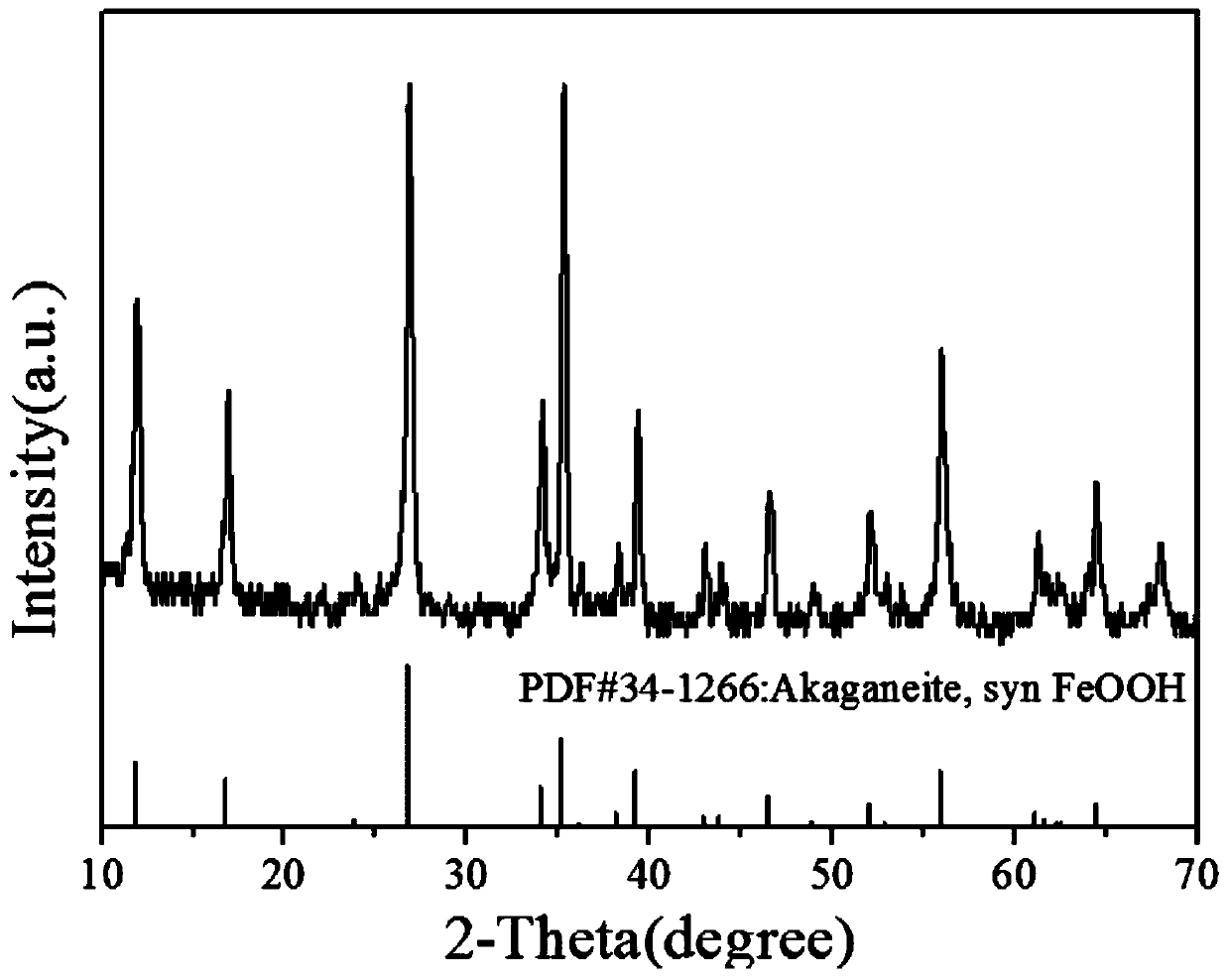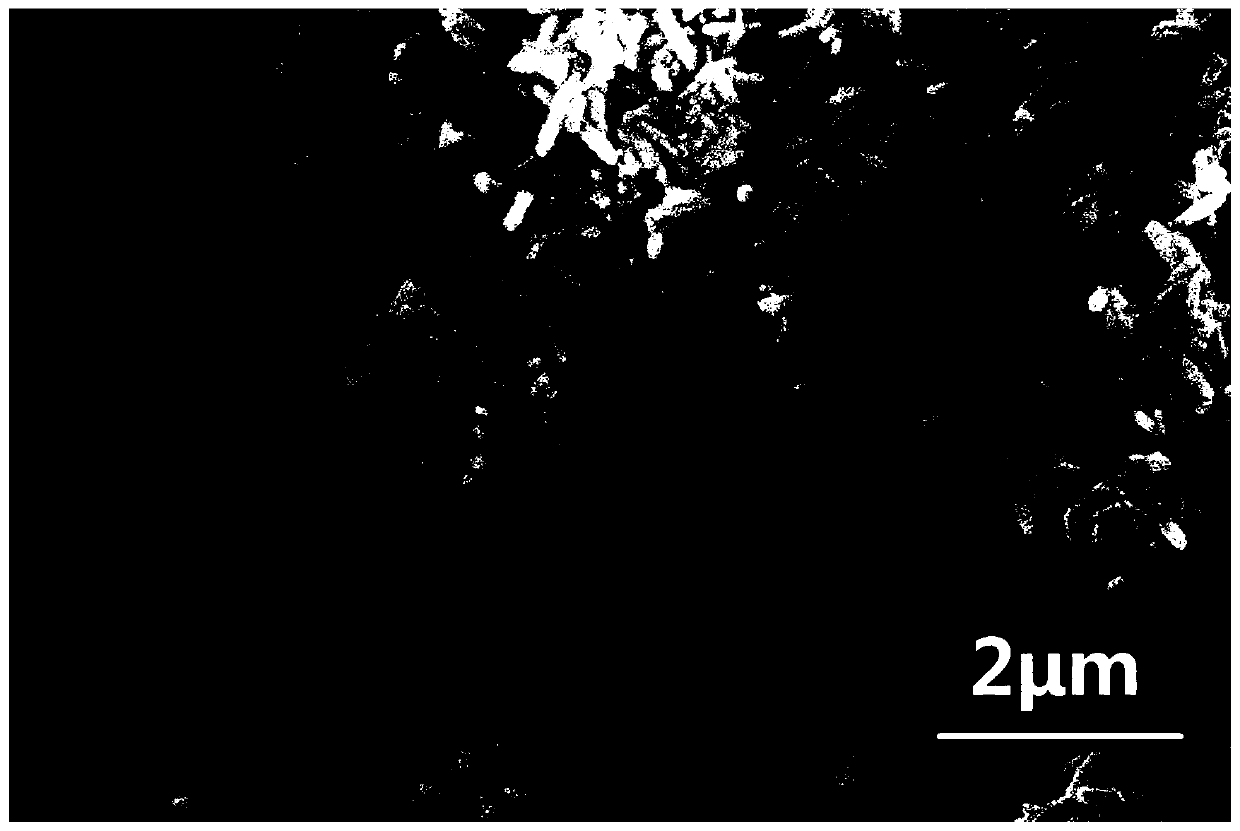A kind of preparation method of nacl modified graphene network coating β-feooh lithium ion battery negative electrode material
A lithium-ion battery and graphene network technology, applied in the field of electrochemistry, can solve problems such as poor conductivity and increase active sites, achieve good conductivity, low cost, and solve the effects of poor conductivity
- Summary
- Abstract
- Description
- Claims
- Application Information
AI Technical Summary
Problems solved by technology
Method used
Image
Examples
Embodiment 1
[0023] 1) Disperse commercially available graphene oxide in 40mL deionized water, the concentration of graphene oxide is 1mg / mL, and then use an ultrasonic generator to disperse it to obtain a uniform graphene oxide suspension A;
[0024] 2) The analytically pure FeCl 3 ·6H 2 O and NaCl were added to 10mL deionized water, stirred to fully dissolve, and then added to suspension A to form a mixed solution of iron salt, sodium salt and graphene oxide, wherein the concentration of iron salt was 0.5mol / L , the sodium salt concentration is 2 / 3 of the iron salt concentration, and then the mixed solution is dispersed by an ultrasonic generator to obtain a suspension B;
[0025] 3) Pour the suspension B prepared above into a homogeneous hydrothermal reaction kettle, control the filling degree to 30%, then seal the reaction kettle, put it into a homogeneous hydrothermal reactor at 100°C for hydrothermal reaction , naturally cooled to room temperature after the reaction to obtain produ...
Embodiment 2
[0032] 1) Disperse commercially available graphene oxide in 35mL deionized water, the concentration of graphene oxide is 2mg / mL, and then use an ultrasonic generator to disperse it to obtain a uniform graphene oxide suspension A;
[0033] 2) The analytically pure FeCl 3 .6H 2 O and NaCl were added to 15mL deionized water, stirred to fully dissolve, and then added to suspension A to form a mixed solution of iron salt, sodium salt and graphene oxide, wherein the concentration of iron salt was 0.4mol / L , the sodium salt concentration is 2 / 3 of the iron salt concentration, and then the mixed solution is dispersed by an ultrasonic generator to obtain a suspension B;
[0034] 3) Pour the suspension B prepared above into a homogeneous hydrothermal reactor, control the filling degree to 50%, then seal the reactor, put it into a homogeneous hydrothermal reactor at 120°C for hydrothermal reaction , naturally cooled to room temperature after the reaction to obtain product C;
[0035] ...
Embodiment 3
[0038] 1) Disperse commercially available graphene oxide in 30mL deionized water, the concentration of graphene oxide is 4mg / mL, and then use an ultrasonic generator to disperse it to obtain a uniform graphene oxide suspension A;
[0039] 2) The analytically pure FeCl 3 .6H 2 O and NaCl were added to 20mL deionized water, stirred to fully dissolve, and then added to suspension A to form a mixed solution of iron salt, sodium salt and graphene oxide, wherein the concentration of iron salt was 0.3mol / L , the sodium salt concentration is 2 / 3 of the iron salt concentration, and then the mixed solution is dispersed by an ultrasonic generator to obtain a suspension B;
[0040] 3) Pour the suspension B prepared above into a homogeneous hydrothermal reaction kettle, control the filling degree to 60%, then seal the reaction kettle, put it into a homogeneous hydrothermal reactor at 140°C for hydrothermal reaction , naturally cooled to room temperature after the reaction to obtain produ...
PUM
 Login to View More
Login to View More Abstract
Description
Claims
Application Information
 Login to View More
Login to View More - R&D
- Intellectual Property
- Life Sciences
- Materials
- Tech Scout
- Unparalleled Data Quality
- Higher Quality Content
- 60% Fewer Hallucinations
Browse by: Latest US Patents, China's latest patents, Technical Efficacy Thesaurus, Application Domain, Technology Topic, Popular Technical Reports.
© 2025 PatSnap. All rights reserved.Legal|Privacy policy|Modern Slavery Act Transparency Statement|Sitemap|About US| Contact US: help@patsnap.com



